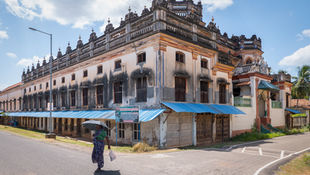Dakshinachitra is a heritage village located in Chennai along the beautiful East Coast Road, dedicated to the cause of the vernacular culture of South India. It is conceived as an interactive outdoor museum, to display the lifestyle of the people. This living heritage museum recites the stories of people through their art, craft, and architecture. The Dakshinachitra design evolution is of a contemporary context that blends traditional elements and has achieved cost-effectiveness in the construction, with a sensitive response to the dictates of climate, location, and availability of materials.

It is conceived as an interactive outdoor heritage Museum, to display the lifestyle of the people. The complex comprises the ticket counter, the reception area, seminar halls, workshop and display surfaces, a craft shop and a bazaar, stores for various items, and a restaurant.
The entrance of Dakshinachitra is extremely welcoming and small like entering a typical South Indian Home. Architectural spaces such as courtyard, verandah, pitched roof, granite columns and stone slabs from old buildings connect flawlessly while cherishing the honour and our culture.
Dakshinachitra Museum Architecture
The roof is a predominant feature in all the buildings. Since the overhang is low in the verandahs, the gables are included to raise the roof at the entrance.

The entrance building of the Dakshinachitra Museum employs a simple rectangular plan with two landscaped courtyards. The brickwork’s hues create a subtle variant. The craft shop’s wall surfaces are whitewashed to provide a contrast with the brightly coloured objects on display.

Courtyards and open spaces allow light and fresh air into the built form and are an aesthetic relief in the complex that incorporates nature within. Verandahs are transition spaces between the exterior and interior, providing gradual variance in the degree of enclosure. They are considered as movement spines that surround the built form.

The Dakshinachitra food court consists of two main dining areas – one fully enclosed and air-conditioned with a bamboo mat ceiling that reduces air conditioning costs, the other pillared and opening into the outside landscape, and a connecting kitchen. The columned space has a high Mangalore tiled roof held up by a system of rafters and beams.

A few small thatched huts along the pathway to the tea shop serve as seating areas that are used as additional spaces during educational workshops, festivals, weddings, and large events.

The craft bazaar is a series of partially covered spaces along the main pathway from the entrance building to the Kerala and Tamil Nadu house sections. It exhibits and sells artefacts and souvenirs made by traditional craftsmen.

Cost-effectiveness has been achieved by the use of natural materials (mud, thatch, and country wood), exposed brickwork, use of arched openings, and reuse of elements such as old doors and windows. The vernacular construction has been executed by traditional craftsmen and skilled masons who used authentic techniques and locally available materials.

Conclusion
The Dakshinachitra public buildings were constructed based on the climatic factors of Chennai. Dakshinachitra heritage museum will remain as a timeless canvas treasuring the life, culture, and tradition of South India. It is a cross-cultural centre where the art, architecture, crafts, and traditions come alive.















Comments